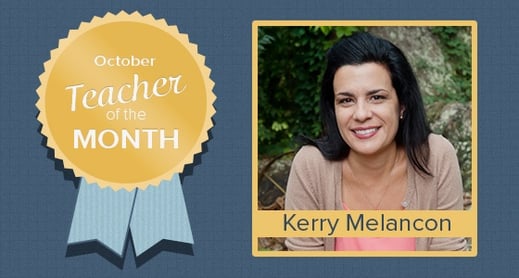
I was so excited to talk to our October Featured Teacher, Kerry Melancon, after getting such a wonderful recommendation from Nicole Angelle, the Early Childhood Supervisor in her parish. Nicole wrote, “Kerry consistently reflects upon the dimensions of the CLASS tool to strengthen her interactions with the students in her classroom … Children feel safe to take risks and explore life knowing they have support for the adults within the classroom. She would be a great example of what a CLASS teacher should be.”
Tell me a little about yourself. How did you get into teaching?
I always knew I wanted to teach. I always enjoyed children. I love their cute little personalities and spirit. And I really love how children always tell the truth. I’ve been at Cecilia Primary School for over 20 years now, and I actually taught 1st, 2nd, and 4th grade before getting into pre-K.
So, what’s your favorite age to teach?
Everyone always asks me that! I always say I love each grade as I teach it, but I really like the young ones. They are always giving hugs and saying, “I love yous.” But it’s fun to see them grow as they get older.
What’s changed since you started teaching?
It’s so different from when we started out. We didn’t have all the technology. There was a lot more center time. And now, there’s a lot more to teach. We have more objectives to cover. Getting kids excited can be challenging.
How did you hear about the CLASS tool?
Well, a couple years ago our supervisors said they would be using the CLASS. All seven pre-K classrooms in our parish use it. So, they told us about it. We weren't surprised. You know, things are always changing in schools. But I was already using a lot of CLASS in my teaching—positive climate, letting students lead, things like that. We really only had to make a few changes. I'd say we embraced it.
How do you use CLASS now?
Oh, we use it all day long. [My paraprofessional and I] always stay positive with the students. We keep a very positive climate in the classroom. We also relate teachings with their everyday lives—even in centers. We often try to have students help teach. Students introduce the lesson. When it's over we ask them to talk about it. I’ll ask them a question about the lesson, but I always make them explain their answer. They can’t just answer the question with a statement. When they have to explain, then they really understand. They’ll be able to help others, and it helps them become independent.
Can you share a story that stands out to you?
One funny story I like to tell is about doing calendar. Every morning we do calendar, and we start with one student coming up and answering, “Why do we need to know about the calendar?” They usually answer with something like, “We need to know if we are going to the library today,” or something like that.
This one student came up and surprised us by saying, “I need to know when my baby is coming!” (She was expecting a little brother or sister.) See? I love how honest kids are! But you can see that she was able to relate calendar time with an everyday example, and she made it personal.
What are some of the biggest challenges you face?
I’d say reaching students that are economically disadvantaged and children who don’t speak English. We have to work really hard with them. During centers we’ll spend extra time with them. We’ll pair them up with a higher-level student to do partner work. We make calls to parents. Because [of these hardships] some are shy, but as the year goes on, we see them come around.
What’s the best part about teaching?
It’s probably just when you’re teaching and you see when the kids finally get a concept or skill. I love seeing expression on their faces—their eyes light up! They can help others and they’ll be independent. I love when they get and get excited about it. And then they have to share with everyone they know—they’ll stop to tell the principal, other teachers, everyone!
What do you wish more people knew about teaching?
That it’s not as easy as you think! People say that it’s easy or that the hours are so good. But it’s hard! It’s hard to stay focused. I try my very best to reach them. We have 20 kids—all demanding. We’re both dedicated to our job. We have to be.
Any final thoughts to share with our readers?
Well, I have two of my own kids. But I think of each of these kids as my kids. I think about how I’d want others teaching them. We do a lot of singing, a lot of dancing. When you make it a positive and fun environment, kids are excited to get dressed in the morning and come to school. And that’s important.

